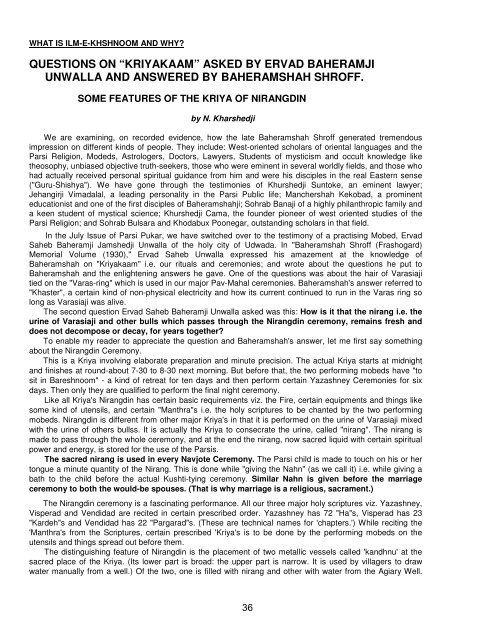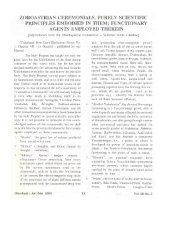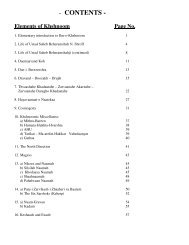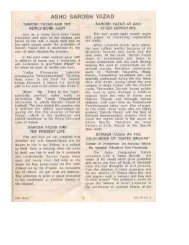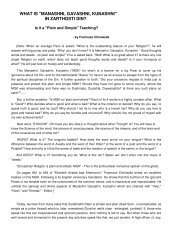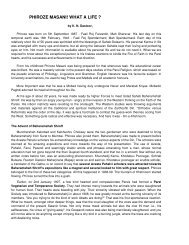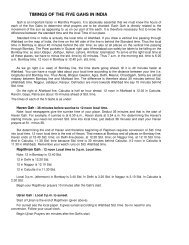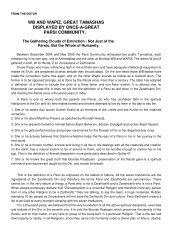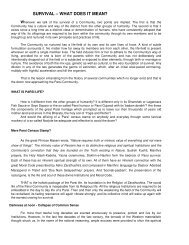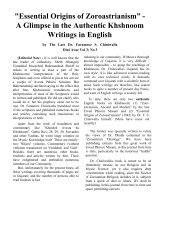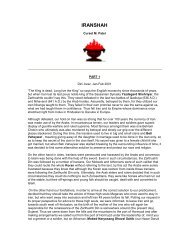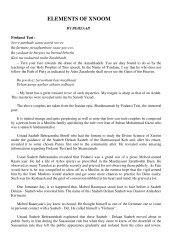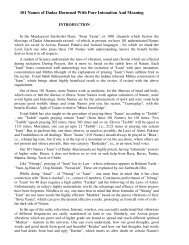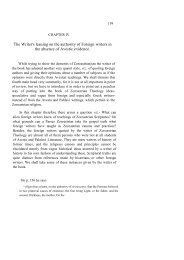Ilm-e-Khshnoom - Traditional Zoroastrianism: Tenets of the Religion
Ilm-e-Khshnoom - Traditional Zoroastrianism: Tenets of the Religion
Ilm-e-Khshnoom - Traditional Zoroastrianism: Tenets of the Religion
You also want an ePaper? Increase the reach of your titles
YUMPU automatically turns print PDFs into web optimized ePapers that Google loves.
WHAT IS ILM-E-KHSHNOOM AND WHY?<br />
QUESTIONS ON “KRIYAKAAM” ASKED BY ERVAD BAHERAMJI<br />
UNWALLA AND ANSWERED BY BAHERAMSHAH SHROFF.<br />
SOME FEATURES OF THE KRIYA OF NIRANGDIN<br />
by N. Kharshedji<br />
We are examining, on recorded evidence, how <strong>the</strong> late Baheramshah Shr<strong>of</strong>f generated tremendous<br />
impression on different kinds <strong>of</strong> people. They include: West-oriented scholars <strong>of</strong> oriental languages and <strong>the</strong><br />
Parsi <strong>Religion</strong>, Modeds, Astrologers, Doctors, Lawyers, Students <strong>of</strong> mysticism and occult knowledge like<br />
<strong>the</strong>osophy, unbiased objective truth-seekers, those who were eminent in several worldly fields, and those who<br />
had actually received personal spiritual guidance from him and were his disciples in <strong>the</strong> real Eastern sense<br />
("Guru-Shishya"). We have gone through <strong>the</strong> testimonies <strong>of</strong> Khurshedji Suntoke, an eminent lawyer;<br />
Jehangirji Vimadalal, a leading personality in <strong>the</strong> Parsi Public life; Manchershah Kekobad, a prominent<br />
educationist and one <strong>of</strong> <strong>the</strong> first disciples <strong>of</strong> Baheramshahji; Sohrab Banaji <strong>of</strong> a highly philanthropic family and<br />
a keen student <strong>of</strong> mystical science; Khurshedji Cama, <strong>the</strong> founder pioneer <strong>of</strong> west oriented studies <strong>of</strong> <strong>the</strong><br />
Parsi <strong>Religion</strong>; and Sohrab Bulsara and Khodabux Poonegar, outstanding scholars in that field.<br />
In <strong>the</strong> July Issue <strong>of</strong> Parsi Pukar, we have switched over to <strong>the</strong> testimony <strong>of</strong> a practising Mobed, Ervad<br />
Saheb Baheramji Jamshedji Unwalla <strong>of</strong> <strong>the</strong> holy city <strong>of</strong> Udwada. In "Baheramshah Shr<strong>of</strong>f (Frashogard)<br />
Memorial Volume (1930)," Ervad Saheb Unwalla expressed his amazement at <strong>the</strong> knowledge <strong>of</strong><br />
Baheramshah on "Kriyakaam" i.e. our rituals and ceremonies; and wrote about <strong>the</strong> questions he put to<br />
Baheramshah and <strong>the</strong> enlightening answers he gave. One <strong>of</strong> <strong>the</strong> questions was about <strong>the</strong> hair <strong>of</strong> Varasiaji<br />
tied on <strong>the</strong> "Varas-ring" which is used in our major Pav-Mahal ceremonies. Baheramshah's answer referred to<br />
"Khaster", a certain kind <strong>of</strong> non-physical electricity and how its current continued to run in <strong>the</strong> Varas ring so<br />
long as Varasiaji was alive.<br />
The second question Ervad Saheb Baheramji Unwalla asked was this: How is it that <strong>the</strong> nirang i.e. <strong>the</strong><br />
urine <strong>of</strong> Varasiaji and o<strong>the</strong>r bulls which passes through <strong>the</strong> Nirangdin ceremony, remains fresh and<br />
does not decompose or decay, for years toge<strong>the</strong>r?<br />
To enable my reader to appreciate <strong>the</strong> question and Baheramshah's answer, let me first say something<br />
about <strong>the</strong> Nirangdin Ceremony.<br />
This is a Kriya involving elaborate preparation and minute precision. The actual Kriya starts at midnight<br />
and finishes at round-about 7-30 to 8-30 next morning. But before that, <strong>the</strong> two performing mobeds have "to<br />
sit in Bareshnoom" - a kind <strong>of</strong> retreat for ten days and <strong>the</strong>n perform certain Yazashney Ceremonies for six<br />
days. Then only <strong>the</strong>y are qualified to perform <strong>the</strong> final night ceremony.<br />
Like all Kriya's Nirangdin has certain basic requirements viz. <strong>the</strong> Fire, certain equipments and things like<br />
some kind <strong>of</strong> utensils, and certain "Manthra"s i.e. <strong>the</strong> holy scriptures to be chanted by <strong>the</strong> two performing<br />
mobeds. Nirangdin is different from o<strong>the</strong>r major Kriya's in that it is performed on <strong>the</strong> urine <strong>of</strong> Varasiaji mixed<br />
with <strong>the</strong> urine <strong>of</strong> o<strong>the</strong>rs bullss. It is actually <strong>the</strong> Kriya to consecrate <strong>the</strong> urine, called "nirang". The nirang is<br />
made to pass through <strong>the</strong> whole ceremony, and at <strong>the</strong> end <strong>the</strong> nirang, now sacred liquid with certain spiritual<br />
power and energy, is stored for <strong>the</strong> use <strong>of</strong> <strong>the</strong> Parsis.<br />
The sacred nirang is used in every Navjote Ceremony. The Parsi child is made to touch on his or her<br />
tongue a minute quantity <strong>of</strong> <strong>the</strong> Nirang. This is done while "giving <strong>the</strong> Nahn" (as we call it) i.e. while giving a<br />
bath to <strong>the</strong> child before <strong>the</strong> actual Kushti-tying ceremony. Similar Nahn is given before <strong>the</strong> marriage<br />
ceremony to both <strong>the</strong> would-be spouses. (That is why marriage is a religious, sacrament.)<br />
The Nirangdin ceremony is a fascinating performance. All our three major holy scriptures viz. Yazashney,<br />
Visperad and Vendidad are recited in certain prescribed order. Yazashney has 72 "Ha"s, Visperad has 23<br />
"Kardeh"s and Vendidad has 22 "Pargarad"s. (These are technical names for 'chapters.') While reciting <strong>the</strong><br />
'Manthra's from <strong>the</strong> Scriptures, certain prescribed 'Kriya's is to be done by <strong>the</strong> performing mobeds on <strong>the</strong><br />
utensils and things spread out before <strong>the</strong>m.<br />
The distinguishing feature <strong>of</strong> Nirangdin is <strong>the</strong> placement <strong>of</strong> two metallic vessels called 'kandhnu' at <strong>the</strong><br />
sacred place <strong>of</strong> <strong>the</strong> Kriya. (Its lower part is broad: <strong>the</strong> upper part is narrow. It is used by villagers to draw<br />
water manually from a well.) Of <strong>the</strong> two, one is filled with nirang and o<strong>the</strong>r with water from <strong>the</strong> Agiary Well.<br />
36


